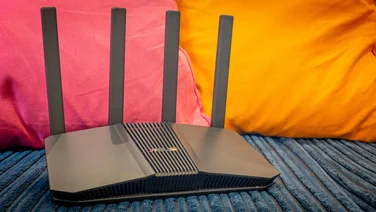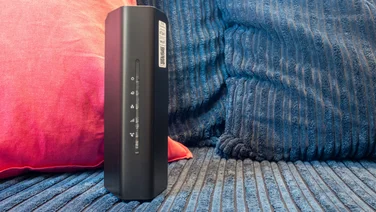To help us provide you with free impartial advice, we may earn a commission if you buy through links on our site. Learn more
- What is Powerline networking?
- Are there different types of Powerline networking adaptors?
- How fast is Powerline networking?
- How secure are Powerline networking adaptors?
- Will Powerline adaptors from different manufacturers work together?
- Will network printers and Wake On LAN (WOL) work with Powerline adaptors?
- Powerline versus Wi-Fi speeds

Wireless networking, when it works, is a truly wonderful thing. However, it’s an unfortunate fact that it simply doesn’t work for everyone. This could be for any number of reasons; a lacklustre router, thick walls and floors or wireless interference can all easily lead to Wi-Fi dead zones plaguing your home.
This can mean that a computer in a spare room can’t maintain a consistent connection or you can only use your smartphone in certain rooms in your home. Neither of these are an ideal scenario. On top of that, not all of your devices might have built-in Wi-Fi, meaning you’re forced to rely on a wired Ethernet connection. That’s fine if say your smart TV is near your router, but what if they’re not? That’s where powerline adapters come in.
No-one wants to have to deal with messy cabling strung across the house. Trying to tape the cables to the skirting or tuck them under a rug is hardly an effective solution, and not everyone is fortunate enough to be able to integrate such cabling behind their walls.
The other issue with Wi-Fi is around network speeds. While you might be able to maintain a consistent connection, wireless speeds are significantly slower than a wired Ethernet connection. This won’t be too much of an issue for browsing the internet but could pose a problem if you are trying to stream content off a NAS or send large files wirelessly between devices.
Powerline networking can help overcome some of these hurdles and has become a popular alternative to Wi-Fi or running a wired network. Even then, they’re still not perfect and there are different standards and attainable speeds.
What is Powerline networking?
Powerline networking, as its name implies, uses your existing electrical power cabling to transmit digital data. In this case, it is used to transfer your networking data. This can essentially be thought of as acting like a wired network, where your electrical wiring replaces a large segment of unsightly Ethernet cable. You’ll still need to run some Ethernet cables, however.
A typical Powerline networking starter kit consists of two adaptors that plug directly into your wall sockets. One adaptor connects your router to one of your power sockets through a short run of Ethernet cable, and a second adaptor uses another Ethernet cable that goes from a second wall socket to the device you want to connect to your network.
The two wall sockets you use with the adaptors can be located in two completely different rooms in your house, helping to bring a network connection to your disparate devices and systems that are otherwise out of reach of your router.

Some Powerline networking devices come with additional useful features, such as Wi-Fi extending. This means you can benefit from both a wired Ethernet connection to a device that perhaps doesn’t support Wi-Fi, but also better wireless reception for your devices that do. You might also have more than one Ethernet port on one of the adaptors, meaning you can connect multiple devices. Alternatively, you can always connect a network switch to one of the Powerline adaptors to have multiple connections.
Certain Powerline networking adaptors will also have power passthrough sockets as well. These are useful as you’ll need to have a wall socket available to plug in the adaptor. A passthrough will mean you won’t have to sacrifice a socket and can still connect other electronics item through the Powerline adaptor if you’re short of sockets around the house.
Once you’ve got a pair working, you can also add more adaptors to extend the network to more locations and devices. Powerline networking can be as simple and plug and play.
Are there different types of Powerline networking adaptors?
The short answer is yes. There are not only different standards but also different specifications within those standards. By far the most common is HomePlug Powerline networks from the HomePlug Alliance. Different vendors make compatible chips that form part of the HomePlug specification, with two of the most prominent being Qualcomm Atheros and Broadcom. These chips are found in Powerline adaptors from well-known networking companies including D-Link, Netgear, TP-Link, Cisco, devolo and ZyXEL and are the most common adaptors found in electronics stores in the UK.

The other area of confusion is around how different adaptors are rated. Initially, there was HomePlug AV, which had a maximum theoretical throughput of 200Mbit/s, which wasn’t particularly fast, especially when compared to a traditional wired Ethernet connection. The introduction of HomePlug AV2 improved matters and allows a theoretical maximum throughput of up to 2,000Mbit/s on newer adaptors.
Not all adaptors will be rated this highly, however, and you pay a premium for the faster speed. Less expensive Powerline adaptors are available with slower maximum speeds, typically 500Mbit/s or 600Mbit/s, so be sure you know what you’re buying.
You’ll also want to check what Ethernet port is included. A standard Ethernet port only allows for 100Mbit/s, even if the Powerline adaptor is rated higher. A Gigabit Ethernet port will allow up to 1,000Mbit/s. You might see devices labelled as PowerLine AV or PowerLine AV2, which slightly compounds confusion.
How fast is Powerline networking?
Like wireless routers, you’re unfortunately never going to get the advertised speeds. There are all manner of environmental factors that will affect your achievable speeds, such as the wiring in your home and distance the signal needs to travel. Other appliances on the same cabling can also have an impact. This means that while a Powerline adaptor might be rated at 500Mbit/s, in reality you might only get half of this in a real world scenario. What this means that you need to have a decent amount of overhead to account for the signal attenuation.
Nowadays, HomePlug AV2 has become the standard, so you’re best to opt for one rated at 500Mbit/s unless you need particularly fast network transfer speeds. One such scenario is if you’re planning on streaming 4K video from a NAS or transferring large files across your home network. For most users, 500Mbit/s is fast enough for everyday use and will be beyond the capabilities of your internet connection speed from your service provider.
How secure are Powerline networking adaptors?
Because Powerline networks use your electrical wiring to transfer data, there is the chance data can be intercepted via crossover with your neighbours – if they’re also using Powerline networking adaptors and have shared wiring. As such, many Powerline networking adaptors have point-to-point encryption that can be easily set up. You’ll just need to hit the relevant security button (sometimes labelled ‘encrypt’) on each adaptor to pair them together.

Your powerline adaptor manufacturer might have software that not only lets you configure security in a more advanced fashion than push-button pairing but will also be able to analyse what other adaptors are on your home wiring.
Will Powerline adaptors from different manufacturers work together?
Provided they are all certified to the HomePlug standard, they should work together without any problems. Even if they’re rated at different speeds. So a 200Mbit/s adaptor should work fine with one rated for 1,200Mbit/s. If you’ve got security set up, you’ll need to make sure that the same password is configured for all adaptors and the same network name used across devices. This might mean having to configure each different manufacturer separately, however.
Will network printers and Wake On LAN (WOL) work with Powerline adaptors?
These should work fine and no differently than if your printer or computer was connected to your router with an Ethernet cable. Usually, any problems that occur happen with Powerline adaptors that are set to go into standby mode after a set amount of time in order to save energy. In order to wake up, they look for a prompt from the network adaptor of the connected computer.
Of course, if you’re looking to use Wake On LAN the connected computer will be turned off and the Powerline adaptor is also in standby, leaving you at a stalemate. You’ll therefore need to make sure you buy a Powerline adaptor that can have any auto-standby functions disabled if you plan on using WOL.
Powerline versus Wi-Fi speeds
Both Wi-Fi and Powerline networking are guilty of claiming theoretical speeds nowhere near their real-world results, so it can be difficult to decide which is the best choice for you. If you take the recent Best Buy award-winning Netgear Powerline 1200 PLP1200-100UKS, we saw speeds of 279.6Mbit/s at 10m and 74.6Mbit/s at 25m. This is a Powerline adaptor rated for 1,200Mbit/s. Compare this with an 802.11ac-capable router like the TP-Link Archer C9, which saw 326.2Mbit/s at 10m and 256.3Mbit/s at 25m (using the 5GHz band). Clearly then, speeds from the 802.11ac router are superior if you care only about file transfer speeds.

It’s not quite so cut and dry, however. The Netgear adaptor’s speed is more than enough for just internet access. A Powerline network adaptor will still also be a good choice if you have a lot of wireless network congestion or live in a house where Wi-Fi reception is an issue. To take advantage of 802.11ac speeds you’ll also need an 802.11ac network adaptor in your device, which could mean a separate cost if it’s a desktop PC you want to connect in a distant room from the router. If you’re a gamer, you’ll also likely have a higher ping using Wi-Fi compared with using a Powerline adaptor. If you just want internet access in the far reaches of your home, Powerline networks are a great solution.






